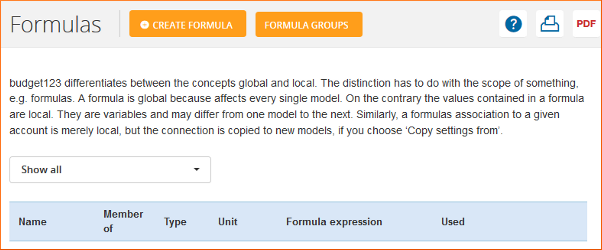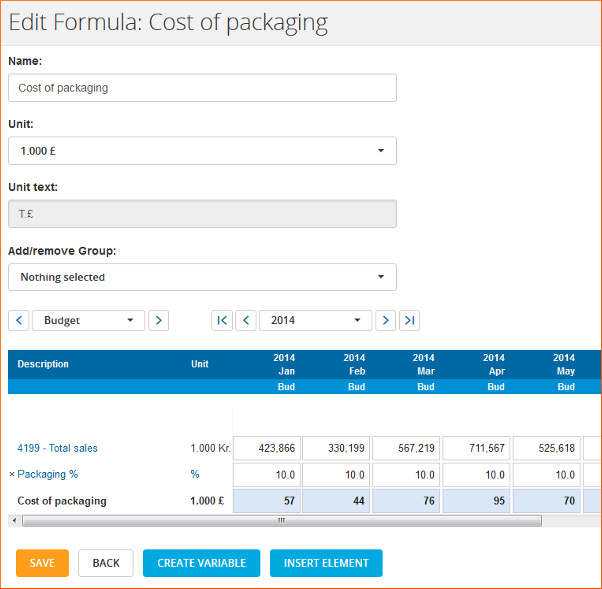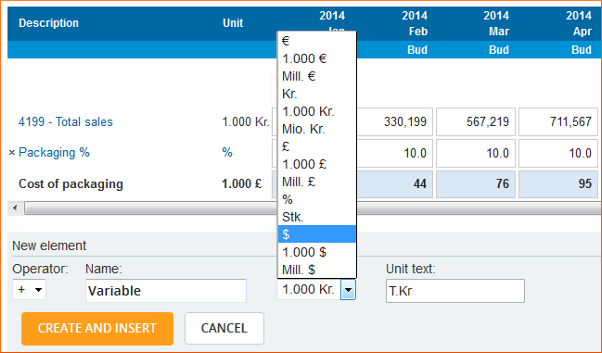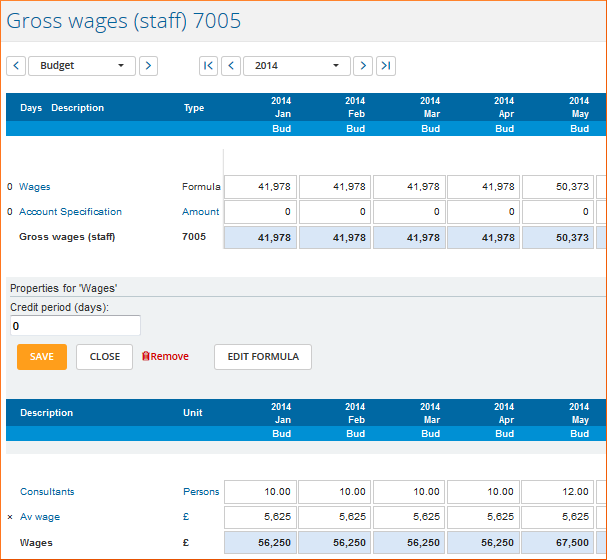Formulas
In Formulas you can see all the formulas and variables that have been created in budget123. You can also create new and edit / delete existing formulas.
For each formula, you can see which account in the active model it has been applied to (click on the account number to go directly to the Account specification). A variable or formula can be applied to multiple accounts at the same time, and it may feature as an element in other formulas.

Use descriptive names
Name your formulas and variables very carefully. Descriptive names will be of great help as the list of formulas grows longer and longer. They will also make it easier to understand the formulas.
Creating formulas
Use the formulas to establish dependencies between accounts or calculations with variables in your budget.
How to work with formulas
The formulas are the mathematical calculations that tell you how the numbers were generated. E.g. you can indicate that the cost of goods sold must be 60 % of your turnover. You can also create complex connections between multiple accounts and any number of variables. For example: Cost of goods sold = number of employees x efficiency (or loss rate) x 40 % (consumption rate) x (Turnover - Shipping (constant)).
Please note!
It is a good idea to create each part of the formula as a separate formula, as this allows you to reuse it in other formulas.

Formulas are global
Please note that the formulas are global. This means that they are automatically created in all your models. The values in the formulas, however, are local.
A formula’s association with an account is also local. Therefore, it may differ from model to model. You can choose to copy the values and whether the formula is "Applied" into a new model. Simply select an existing model to "Copy settings from:" and tick the boxes below to include “Variable values” and “Account links (applied)”.
Circular references
budget123 does not protect you against circular references, that is, calculations that refer to themselves. You should always check your formulas and results. Please also pay attention to the units used in each part of your formulas.
Creating variables
When you create a formula, you can also create variables to be included in the calculation. Variables represent a measurable quantity or an expression that can vary over time. You must enter a name for your variables and the values for the budget period.

Examples of variables include 'number of employees', 'prices', 'percentages' etc.
In budget123 you can create variables using these units:
|
| Ører |
€ cent |
Pence |
§ Cent |
| Kroner |
€ |
£ |
§ |
| 1,000 kr. |
1.000 € |
1.000 £ |
1.000 § |
| 1,000,000 kr. |
Mill. € |
Mill. £ |
Mill. § |
| Percent |
Stk. (units) |
|
|
|
Variables are global
Please note that a variable is global, which means that it is created in all your models. In contrast, the value in the variable is local, so the values you enter can only be found in the active model.
When you create a new model, you can copy all your values from your variables to the new model simply by selecting to “Copy settings from:” an existing model and ticking the box below to include ‘variable values’.
Edit variables
To edit a variable, go to Modules, select Formulas and click on the variable in the list. You can also change the values in the variable by clicking on the account in which the variable (formula) is used. Click on the account name and then on the formula name.

Remember that you can change all the values, simply by clicking on the unit in each line and selecting one of the Distribution keys.